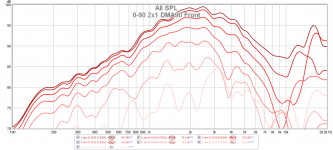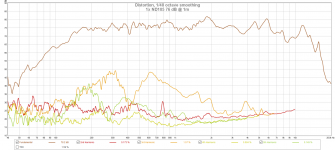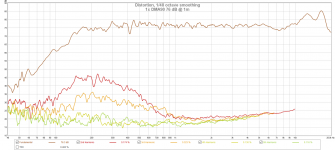Can a well balanced dipole (symmetrical front and back) make a good approximation of an omni in room?
No. In a way they sound similarly "spacious", but depending of positioning sound can be very different. I have a pair of dipoles and a pair of omnis, but omnis are at summer cabin...
This illustration misses the opposite polarity of dipoles's backside radiation.

Understood. Whilst moving around them the output will vary but the spectral balance should ideally remain the same.
A cone driver upside down will cork only for bass. The spider and motor structures make wild interferences above say 500Hz.
I'd like to chime in on this thread. I have been working with dipole systems exclusively over the last 6 years or so, and lately I have been paying more attention to the rear radiation from a dipole driver, especially when used nude (e.g. without baffle, just the driver hanging there in space). I have made a bunch of measurements on drivers of various diameters in the rear plane (the side that the magnet is on) when hanging freely.
What Juhazi says above is true but in my opinion the frequency where the driver is no longer working well from the rear will depend somewhat on its cone diameter, the diameter of the magnet vs frame OD, and the available open area through the basket assembly to radiate out from the rear of the cone. A relatively modest diameter cone driver, e.g. 6-7", can work up to 1k and sometimes higher but usually not above 2k. This diameter driver is already becoming somewhat directional around 1kHz, so if the intended use was for an omni system you need to look at that closely. As the driver diameter increases, the directionality will get worse and the usable upper frequency will decrease.
The bottom line is that each and every driver is different and you should measure it to know exactly what you are dealing with.
One would hope so with an omni speaker!....the spectral balance should ideally remain the same.
"Perfect omnipole" must be as difficult to achieve as "perfect dipole" Challenged above 1-2kHz both horizontally and especially vertically.
Non-uniform directivity will make room response differencies, depending on how refections will affect the sound. This cannot even be seen in long gated measured room response or csd, because we hear late reflections as integral part of "the sound".
Anyway, my experience tells that the difference is smaller than you might guess!
Non-uniform directivity will make room response differencies, depending on how refections will affect the sound. This cannot even be seen in long gated measured room response or csd, because we hear late reflections as integral part of "the sound".
Anyway, my experience tells that the difference is smaller than you might guess!
Interesting, thanks. I've not heard any omnis but walking around my dipoles the sound seems quite uniform, spectrum wise, I get good nulls but it still sounds balanced, I wondered if it was similar to omnis.Anyway, my experience tells that the difference is smaller than you might guess!
Can a well balanced dipole (symmetrical front and back) make a good approximation of an omni in room?
Somewhat, I had omnis but i abandoned them for dipoles as I found the dipoles to sound better. Both have very uniform response so in practice they sound the same everywhere as long as you aren't in the null direction.
And I might be late to the party but the rear of speakers is quite different to the front:
Here are measurements of the 3.5" Dayton DMA90 (which is a fantastic driver by the way).
It has an extremely open back so performes really well as a dipole and is quite small but as you see the rear response is nowhere close to the front response.
Most drivers are way worse though, only open drivers with small magnets perform this well. A normal driver with a big ferrite magnet will have a high Q peak right before the drop and not be as smooth.
Here are measurements of the 3.5" Dayton DMA90 (which is a fantastic driver by the way).
It has an extremely open back so performes really well as a dipole and is quite small but as you see the rear response is nowhere close to the front response.
Most drivers are way worse though, only open drivers with small magnets perform this well. A normal driver with a big ferrite magnet will have a high Q peak right before the drop and not be as smooth.
Attachments
And I might be late to the party but the rear of speakers is quite different to the front:
Here are measurements of the 3.5" Dayton DMA90 (which is a fantastic driver by the way).
It has an extremely open back so performes really well as a dipole and is quite small but as you see the rear response is nowhere close to the front response.
Most drivers are way worse though, only open drivers with small magnets perform this well. A normal driver with a big ferrite magnet will have a high Q peak right before the drop and not be as smooth.
Thanks for sharing your measurements. How did you make them (was the driver mounted to a baffle)? Did you also measure distortion performance?
This looks pretty good for a cone type driver and would make a great "fill" driver in the 700-2k range, or over a slightly wider range. The only issue seems to be a resonance or something around 1.2k on the back side only, but it's not all that severe.
In nude dipoles I find that it's critical to identify a driver that can cover this mid-band (up to about 2k Hz). A woofer that can reach to 100Hz and below is going to have some issues by 800Hz or so, and a dipole tweeter typically cannot be operated below 2kHz. This gives rise to the mid-gap that requires the "right" driver to stay dipole in this range. At only $15 the DMA90 seems to be a great and economical choice. I will have to get a pair and give them a try.
You could probably cut away half of those ribs? 😉At only $15 the DMA90 seems to be a great and economical choice. I will have to get a pair and give them a try.
You could probably cut away half of those ribs? 😉
Probably simple and easy to do using a "nipper" style wire cutting tool:

Can a well balanced dipole (symmetrical front and back) make a good approximation of an omni in room?
AFAIK it can, but it depends op the setup. Dipoles generally need more space behind them to sound good (space to the side wall isn't very important). They tend to have high efficiency since both the front and back wave are being fully used to fill the room with sound. This doesn't work for me since my speakers will be more close to the corners of the room, which causes weird interferences between the front and back, as far as I know. But for someone who wants omni sound and who's got a room dedicated to music listening, dipoles are definitely an option worth considering imo
Please correct me if I'm wrong! 🙂
Here are measurements of the 3.5" Dayton DMA90 (which is a fantastic driver by the way).
Those measurements are quite interesting... The additional info as well. Good stuff, thank you all for the posts and comments
Last edited:
What great service! I'm not even a customer (yet)! 🙂
---
Let's have a look. To me, on first sight this actually looks really good and perhaps even promising??
As someone who has never had a DIY-audio teacher and who had to figure out all the physics and mechanics behind speakers for himself, I find it a little hard to draw conclusions from these graphs. Can someone help me interpret these graphs?
My first thoughts would be:
Graph 1: The dip at 4.5k, is that breakup? or rather a product of the driver's directionality in combination with the exact placement of the listener (the mic)?
Graph 2: Above 4k or so, the graph starts spiking like crazy. Could I still expect the driver to sound good in the higher regions, or would this imply nasty cone breakup stuff that I don't know much about yet?
Graph 3: 2.5k and 4k, again, normal dips or nasty bad-sounding cone breakup?
Not sure about this! 😀
---
Let's have a look. To me, on first sight this actually looks really good and perhaps even promising??
As someone who has never had a DIY-audio teacher and who had to figure out all the physics and mechanics behind speakers for himself, I find it a little hard to draw conclusions from these graphs. Can someone help me interpret these graphs?
My first thoughts would be:
Graph 1: The dip at 4.5k, is that breakup? or rather a product of the driver's directionality in combination with the exact placement of the listener (the mic)?
Graph 2: Above 4k or so, the graph starts spiking like crazy. Could I still expect the driver to sound good in the higher regions, or would this imply nasty cone breakup stuff that I don't know much about yet?
Graph 3: 2.5k and 4k, again, normal dips or nasty bad-sounding cone breakup?
Not sure about this! 😀
Attachments
Well, well, well. Super nice of them to do that, you caught someone's curiosity.
I see they got the on axis swapped buy fixed it with the arrows.
The second row at 45 degrees is where you'd likely be listening. But even 9- degrees off is surprising. I'm surprised at the amount of high end still coming off the back of the driver.
I see they got the on axis swapped buy fixed it with the arrows.
The second row at 45 degrees is where you'd likely be listening. But even 9- degrees off is surprising. I'm surprised at the amount of high end still coming off the back of the driver.
Thanks for sharing your measurements. How did you make them (was the driver mounted to a baffle)? Did you also measure distortion performance?
This looks pretty good for a cone type driver and would make a great "fill" driver in the 700-2k range, or over a slightly wider range. The only issue seems to be a resonance or something around 1.2k on the back side only, but it's not all that severe.
In nude dipoles I find that it's critical to identify a driver that can cover this mid-band (up to about 2k Hz). A woofer that can reach to 100Hz and below is going to have some issues by 800Hz or so, and a dipole tweeter typically cannot be operated below 2kHz. This gives rise to the mid-gap that requires the "right" driver to stay dipole in this range. At only $15 the DMA90 seems to be a great and economical choice. I will have to get a pair and give them a try.
Of course I measured distortion =)
The drivers were measured naked and suspended at 50 cm distance. They have moderate EQ applied such that the response targets a flat response with 140 hz 24 dB highpass. They are both given the same signal except that the ND105 has the LR2 highpass shifted from 140 hz to 155 hz as it had a bit more efficiency on the lowest end.
But look at how smooth the DMA90 measures over the whole range! The ND105 has lots of peaks and dips and while it technically has more xmax it isn't as clean, look at those ugly odd order distortion peaks. Unless you have an array of them you probably want to cross them higher thogh to avoid that distortion bump. My current plan is a line of ~ 16 of them where every other driver is inverted to null some of that 2nd order distortion on the low end.
Attachments
My current plan is a line of ~ 16 of them where every other driver is inverted to null some of that 2nd order distortion on the low end.
Is this comparable to XLR being balanced?
So I mean: Let's say every dipole in your array distorts. Then the distortion in the backwave from half of the dipole drivers (which is 180° out-of-phase with the distortion from the front facing ones front-facing ones) cancels out the distortion from the front-facing drivers
Am I getting this right?
Last edited:
- Home
- Loudspeakers
- Multi-Way
- back wave in comparison to front wave




